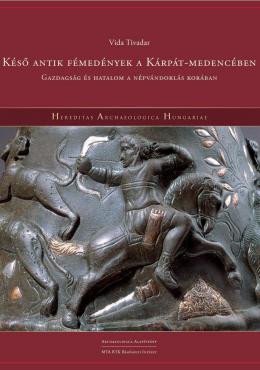Késő antik fémedények a Kárpát-medencében

Késő antik fémedények a Kárpát-medencében
| 3 800 Ft |
| Price |
Hereditas Archaeologicae Hungariae
Budapest, Archaeolingua, 2016
Puhakötés | Paper book
143 oldal, színes és fekete-fehér illusztrációkkal | 143 pages with colored and grayscale images
ISBN 978-963-9911-77-2
This book is also available in English
Table of contents // Tartalomjegyzék
Description
The legacy of the Late Bronze Age communities populating the Carpathian Basin between the 14th and 10th centuries BC represents the perhaps most colourful and numerous range of artefacts before the Roman conquest. These people transformed the landscape on a previously unprecedented scale with the erection of tumuli over their burials and the construction of monumental hillforts; they drew previously unbroken land into cultivation and founded many dozens of new settlements deep in the forest-covered hills and mountains. Their most spectacular relics are the hoards containing a dazzling array of bronze and gold articles, whose deposition and concealment has fuelled incessant debates for over a century. We now know that the assemblages containing valuable weapons, jewellery and a variety of tools and implements were assembled according to specific cultural norms. Each of these hoards has a different story to tell: some preserve the memory of journeys to distant lands, spectacular rituals and sumptuous feasts, others evoke the toils of daily life and bloody wars. The widespread deposition and concealment of hoards is solely attested in Bronze Age Europe during the 2nd millennium BC – a similar practice is unknown during other periods in the history of Europe or on other continents. The research team headed by the author has systematically visited the known Bronze Age sites of Hungary and conducted metal detecting surveys in order to locate and salvage as many as possible of the Bronze Age treasures still hidden in the ground. This book offers a fascinating glimpse into this long bygone age through discovered hoards, bringing us closer to the peoples who buried them and the possible event behind their concealment.
Leírás
A népvándorlás kori barbár előkelőkhöz ajándék, zsákmány, vagy kereskedelem révén eljutott arany-, ezüst- és rézedények a késő ókori mediterrán civilizáció és a peremén létrejött törzsi királyságok közötti sokoldalú kapcsolatrendszerről tanúskodnak. E pompás tárgyak mint értékes szerzemények az előkelők házának díszei voltak, és közösségi rendezvények, ünnepi lakomák fényét emelték. A drága, nemesfémből készült edények mint diplomáciai ajándékok fontos szerepet kaptak a késő ókori állam és a barbár királyságok közötti jó viszony fenntartásában, a szövetség megpecsételésében. Státuszszimbólumok maradtak a Római Birodalom határain túl is, kecses formájuk és díszítésük kifejezte a késő ókori arisztokrácia rangját, megjelenítette világnézetét, a szépségről és a „jó életről” vallott eszményeit, még ha olykor módosult formában is. E díszedények tovább ajándékozás vagy cserék révén alkalmasak voltak a barbár vezetőség tagjai közötti viszony ápolására is. A mindennapokban használt színesfém edények inkább a középrétegekhez köthetőek, jelezve, hogy ez a szélesebb társadalmi réteg is a maga módján a késő ókori arisztokrácia életmódjának, így étkezési szokásainak és asztalkészletének követésére törekedett. A késő antik és kora bizánci fémedények nemcsak tulajdonosaik életében voltak a társadalmi reprezentáció megkülönböztetett eszközei, hanem sírjukba helyezve haláluk után is.
| |
|
|
1067 Budapest, Teréz krt. 13. |
|
|
|
|
About us
The Archaeolingua Foundation and Publisher is involved in publishing series and standalone publications in the disciplines of archaeology, linguistics, historic sciences and heritage protection for over 25 years.
Learn more
Publishing
We publish both as standalone editions and as a volume of a professional series.
Learn more
Contact us
Archaeolingua Foundation

